Improving Anti-Corrosion and Conductivity of NiTi Alloy Bipolar Plate Used for PEMFCs via Nb Alloying
Abstract
1. Introduction
2. Results and Discussion
3. Materials and Methods
3.1. Materials
3.2. Electrochemical Measurements
3.3. ICR Measurements
3.4. Characterization
4. Conclusions
Supplementary Materials
Author Contributions
Funding
Institutional Review Board Statement
Informed Consent Statement
Data Availability Statement
Conflicts of Interest
References
- Ang, T.-Z.; Salem, M.; Kamarol, M.; Das, H.S.; Nazari, M.A.; Prabaharan, N. A Comprehensive Study of Renewable Energy Sources: Classifications, Challenges and Suggestions. Energy Strategy Rev. 2022, 43, 100939. [Google Scholar] [CrossRef]
- Niu, Z.; Wang, X.; Li, Y.; He, Z.; Huang, F.; Deng, Q.; Hu, F.; Zhou, Q. Review of Conductive Polymer Coatings for Metallic Bipolar Plates in Proton Exchange Membrane Fuel Cells. J. Polym. Mater. 2025, 42, 57–80. [Google Scholar] [CrossRef]
- Atapour, M.; Rajaei, V.; Trasatti, S.; Casaletto, M.P.; Chiarello, G.L. Thin Niobium and Niobium Nitride PVD Coatings on AISI 304 Stainless Steel as Bipolar Plates for PEMFCs. Coatings 2020, 10, 889. [Google Scholar] [CrossRef]
- Zhao, J.; Tu, Z.; Chan, S.H. Carbon Corrosion Mechanism and Mitigation Strategies in a Proton Exchange Membrane Fuel Cell (PEMFC): A Review. J. Power Sources 2021, 488, 229434. [Google Scholar] [CrossRef]
- Ha, H.; Gong, M.; Choi, B.; Na, Y. Design of Stiffened Ribs for Improving Forming Defects of Metal Bipolar Plate for PEMFC. Int. J. Precis. Eng. Manuf.-Green Tech. 2025, 12, 935–950. [Google Scholar] [CrossRef]
- Xiong, K.; Wu, W.; Wang, S.; Zhang, L. Modeling, Design, Materials and Fabrication of Bipolar Plates for Proton Exchange Membrane Fuel Cell: A Review. Appl. Energy 2021, 301, 117443. [Google Scholar] [CrossRef]
- Liu, Q.; Lan, F.; Zeng, C.; Chen, J.; Wang, J. A Review of Proton Exchange Membrane Fuel Cell’s Bipolar Plate Design and Fabrication Process. J. Power Sources 2022, 538, 231543. [Google Scholar] [CrossRef]
- Gao, X.; Chen, J.; Xu, R.; Zhen, Z.; Zeng, X.; Chen, X.; Cui, L. Research Progress and Prospect of the Materials of Bipolar Plates for Proton Exchange Membrane Fuel Cells (PEMFCs). Int. J. Hydrogen Energy 2024, 50, 711–743. [Google Scholar] [CrossRef]
- Wu, X.; Xing, S.; Luo, J.; Wang, H.; Huang, F.; Zhao, C. Progress and Challenges on Air-Cooled Open-Cathode Proton Exchange Membrane Fuel Cells: Materials, Structures, and Systems. Energy Rev. 2025, 4, 100130. [Google Scholar] [CrossRef]
- Jeong, K.I.; Oh, J.; Song, S.A.; Lee, D.; Lee, D.G.; Kim, S.S. A Review of Composite Bipolar Plates in Proton Exchange Membrane Fuel Cells: Electrical Properties and Gas Permeability. Compos. Struct. 2021, 262, 113617. [Google Scholar] [CrossRef]
- Maheshwari, P.H.; Mathur, R.B.; Dhami, T.L. Fabrication of High Strength and a Low Weight Composite Bipolar Plate for Fuel Cell Applications. J. Power Sources 2007, 173, 394–403. [Google Scholar] [CrossRef]
- Li, W.; Xie, Z.; Qiu, S.; Zeng, H.; Liu, M.; Wu, G. Improved Performance of Composite Bipolar Plates for PEMFC Modified by Homogeneously Dispersed Multi-Walled Carbon Nanotube Networks Prepared by In Situ Chemical Deposition. Nanomaterials 2023, 13, 365. [Google Scholar] [CrossRef]
- Leng, Y.; Ming, P.; Yang, D.; Zhang, C. Stainless Steel Bipolar Plates for Proton Exchange Membrane Fuel Cells: Materials, Flow Channel Design and Forming Processes. J. Power Sources 2020, 451, 227783. [Google Scholar] [CrossRef]
- Chen, Z.; Zhang, G.; Yang, W.; Xu, B.; Chen, Y.; Yin, X.; Liu, Y. Superior Conducting Polypyrrole Anti-Corrosion Coating Containing Functionalized Carbon Powders for 304 Stainless Steel Bipolar Plates in Proton Exchange Membrane Fuel Cells. Chem. Eng. J. 2020, 393, 124675. [Google Scholar] [CrossRef]
- Gong, J.; Wei, H.; Hao, P.; Li, S.; Zhao, X.; Tang, Y.; Zuo, Y. Study on the Influence of Metal Substrates on Protective Performance of the Coating by EIS. Materials 2024, 17, 378. [Google Scholar] [CrossRef]
- Saikia, M.; Dutta, T.; Jadhav, N.; Kalita, D.J. Insights into the Development of Corrosion Protection Coatings. Polymers 2025, 17, 1548. [Google Scholar] [CrossRef]
- Yuan, Z.; Chu, H.; Pan, Y.; Li, F.; Wang, X.; Li, L.; Hu, P.; Du, B.; Hayat, M.D. Enhanced Conductivity Behavior of Titanium-Based Bipolar Plate Oxide Films through Microalloying: First-Principles Calculations and Experimental Investigations. Ceram. Int. 2024, 50, 4101–4108. [Google Scholar] [CrossRef]
- Li, Y.; Wang, X.; Li, Y.; He, Z.; Zhang, G.; Wang, Z.; Wang, S.; Hu, F.; Zhou, Q. Corrosion and Interfacial Contact Resistance of NiTi Alloy as a Promising Bipolar Plate for PEMFC. Molecules 2024, 29, 3696. [Google Scholar] [CrossRef] [PubMed]
- Zhu, H.; Wang, X.; Meng, W.; Ming, P.; Kong, F. Effect of Annealing Time on Microstructure and Properties of Ti-Nb-Ni Sheets as Bipolar Plates Substrates. Int. J. Hydrogen Energy 2024, 57, 1263–1272. [Google Scholar] [CrossRef]
- Ishikawa, K.; Saeki, Y.; Miyajima, Y.; Watanuki, T.; Machida, A. Effects of Rolling and Annealing on Hydrogen Permeability and Crystal Orientation in Nb-TiNi Two-Phase Alloys. Int. J. Hydrogen Energy 2019, 44, 23101–23106. [Google Scholar] [CrossRef]
- Liu, L.; Huang, T.; Qu, M.; Liu, G.; Zhang, J.; Fu, H. High Thermal Gradient Directional Solidification and Its Application in the Processing of Nickel-Based Superalloys. J. Mater. Process. Technol. 2010, 210, 159–165. [Google Scholar] [CrossRef]
- Sitepu, H. Texture and Structural Refinement Using Neutron Diffraction Data from Molybdite (MoO3) and Calcite (CaCO3) Powders and a Ni-Rich Ni50.7Ti49.30Alloy. Powder Diffr. 2009, 24, 315–326. [Google Scholar] [CrossRef]
- Lejaeghere, K.; Van Speybroeck, V.; Van Oost, G.; Cottenier, S. Error Estimates for Solid-State Density-Functional Theory Predictions: An Overview by Means of the Ground-State Elemental Crystals. Crit. Rev. Solid State Mater. Sci. 2014, 39, 1–24. [Google Scholar] [CrossRef]
- Zhang, Y.H.; Li, H.; Yang, Z.W.; Liu, X.; Gu, Q.F. Microstructure Evolution and Shape Memory Behaviors of Ni47Ti44Nb9 Alloy Subjected to Multistep Thermomechanical Loading with Different Prestrain Levels. J. Mater. Sci. Technol. 2024, 171, 80–93. [Google Scholar] [CrossRef]
- Cheng, H.; Luo, H.; Wang, X.; Dong, C.; Li, X. Effect of Fluoride Ion Concentration and Fluctuating Conditions on Titanium Bipolar Plate in PEM Water Electrolyser Environment. Corros. Sci. 2023, 222, 111414. [Google Scholar] [CrossRef]
- Zhou, Q.; Sheikh, S.; Ou, P.; Chen, D.; Hu, Q.; Guo, S. Corrosion Behavior of Hf0.5Nb0.5Ta0.5Ti1.5Zr Refractory High-Entropy in Aqueous Chloride Solutions. Electrochem. Commun. 2019, 98, 63–68. [Google Scholar] [CrossRef]
- Asri, N.F.; Husaini, T.; Sulong, A.B.; Majlan, E.H.; Daud, W.R.W. Coating of Stainless Steel and Titanium Bipolar Plates for Anticorrosion in PEMFC: A Review. Int. J. Hydrogen Energy 2017, 42, 9135–9148. [Google Scholar] [CrossRef]
- Jayaraj, J.; Kim, Y.C.; Kim, K.B.; Seok, H.K.; Fleury, E. Corrosion Studies on Fe-Based Amorphous Alloys in Simulated PEM Fuel Cell Environment. Sci. Technol. Adv. Mater. 2005, 6, 282–289. [Google Scholar] [CrossRef]
- Wang, Y.; Northwood, D. An Investigation of the Electrochemical Properties of PVD TiN-Coated SS410 in Simulated PEM Fuel Cell Environments. Int. J. Hydrogen Energy 2007, 32, 895–902. [Google Scholar] [CrossRef]
- Lee, H.-Y.; Lee, S.-H.; Kim, J.-H.; Kim, M.-C.; Wee, D.-M. Thermally Nitrided Cu–5.3Cr Alloy for Application as Metallic Separators in PEMFCs. Int. J. Hydrogen Energy 2008, 33, 4171–4177. [Google Scholar] [CrossRef]
- Lee, C.-H.; Lee, Y.-B.; Kim, K.-M.; Jeong, M.-G.; Lim, D.-S. Electrically Conductive Polymer Composite Coating on Aluminum for PEM Fuel Cells Bipolar Plate. Renew. Energy 2013, 54, 46–50. [Google Scholar] [CrossRef]
- Bi, F.; Yi, P.; Zhou, T.; Peng, L.; Lai, X. Effects of Al Incorporation on the Interfacial Conductivity and Corrosion Resistance of CrN Film on SS316L as Bipolar Plates for Proton Exchange Membrane Fuel Cells. Int. J. Hydrogen Energy 2015, 40, 9790–9802. [Google Scholar] [CrossRef]
- Mi, B.; Wang, Q.; Qi, T.; Qin, Z.; Chen, Z.; Wang, H. Performance and Structure of Ti-Doped Amorphous Carbon/CrN/Ti Multilayer Coating Deposited on 316L Stainless Steel for Use as Bipolar Plate in Proton Exchange Membrane Fuel Cell. J. Alloys Compd. 2023, 943, 169080. [Google Scholar] [CrossRef]
- Ma, T.; Guo, H.; Tian, Y.; Qi, J.; Yao, N. TiZrC-Coated 316 L Stainless Steel Bipolar Plates for Proton Exchange Membrane Fuel Cells. Mater. Today Commun. 2025, 42, 111170. [Google Scholar] [CrossRef]
- Rosero-Navarro, N.C.; Pellice, S.A.; Durán, A.; Aparicio, M. Effects of Ce-Containing Sol–Gel Coatings Reinforced with SiO2 Nanoparticles on the Protection of AA2024. Corros. Sci. 2008, 50, 1283–1291. [Google Scholar] [CrossRef]
- Iversen, A.K. Stainless Steels in Bipolar Plates—Surface Resistive Properties of Corrosion Resistant Steel Grades during Current Loads. Corros. Sci. 2006, 48, 1036–1058. [Google Scholar] [CrossRef]
- Boissy, C.; Ter-Ovanessian, B.; Mary, N.; Normand, B. Correlation between Predictive and Descriptive Models to Characterize the Passive Film—Study of Pure Chromium by Electrochemical Impedance Spectroscopy. Electrochim. Acta 2015, 174, 430–437. [Google Scholar] [CrossRef]
- Zhao, L.; Dai, H.; Pei, F.; Ming, P.; Wei, X.; Zhou, J. A Comparative Study of Equivalent Circuit Models for Electro-Chemical Impedance Spectroscopy Analysis of Proton Exchange Membrane Fuel Cells. Energies 2022, 15, 386. [Google Scholar] [CrossRef]
- Cao, C.; Liang, C.; Huang, N. Electrochemical Behavior of Niobium Electrodeposited 316 Stainless Steel Bipolar Plate for PEMFC in Choline Chloride Based Ionic Liquids. J. Wuhan Univ. Technol.-Mater. Sci. Ed. 2015, 30, 1061–1067. [Google Scholar] [CrossRef]
- Nascimento, J.P.L.D.; Ferreira, M.O.A.; Gelamo, R.V.; Sampaio, R.M.D.S.; Slade, N.B.L.; Moreto, J.A.; Fernandes, J.C.S. Corrosion and Solid-State Properties of Nb2O5 Coating Deposited on Ti-6Al-4V Alloy via DC Reactive Sputtering. Electrochim. Acta 2025, 530, 146323. [Google Scholar] [CrossRef]
- Zhang, D.; Duan, L.; Guo, L.; Wang, Z.; Zhao, J.; Tuan, W.-H.; Niihara, K. TiN-Coated Titanium as the Bipolar Plate for PEMFC by Multi-Arc Ion Plating. Int. J. Hydrogen Energy 2011, 36, 9155–9161. [Google Scholar] [CrossRef]
- Pugal Mani, S.; Srinivasan, A.; Rajendran, N. Effect of Nitrides on the Corrosion Behaviour of 316L SS Bipolar Plates for Proton Exchange Membrane Fuel Cell (PEMFC). Int. J. Hydrogen Energy 2015, 40, 3359–3369. [Google Scholar] [CrossRef]
- Wang, L.; Tao, Y.; Zhang, Z.; Wang, Y.; Feng, Q.; Wang, H.; Li, H. Molybdenum Carbide Coated 316L Stainless Steel for Bipolar Plates of Proton Exchange Membrane Fuel Cells. Int. J. Hydrogen Energy 2019, 44, 4940–4950. [Google Scholar] [CrossRef]
- Wang, H. Stainless Steel as Bipolar Plate Material for Polymer Electrolyte Membrane Fuel Cells. J. Power Sources 2003, 115, 243–251. [Google Scholar] [CrossRef]
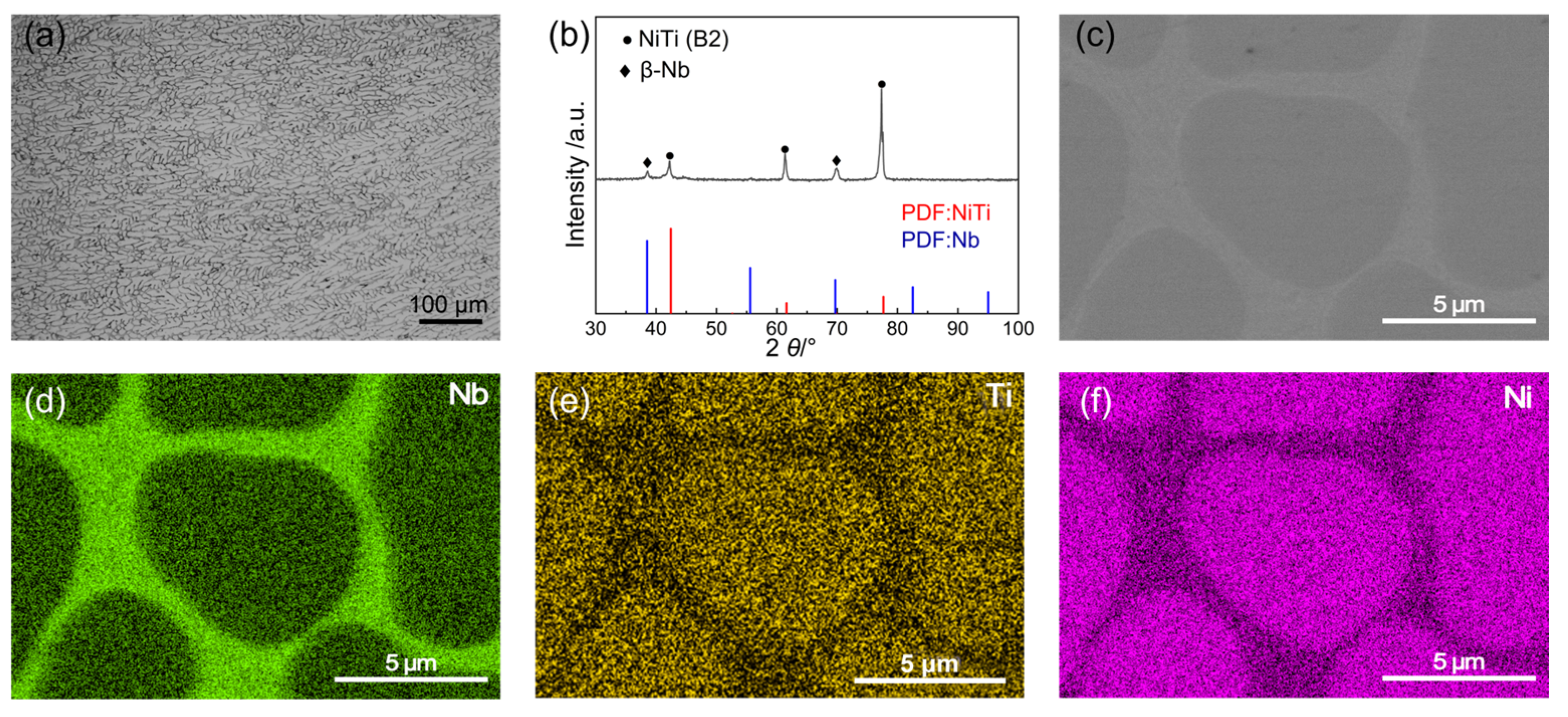
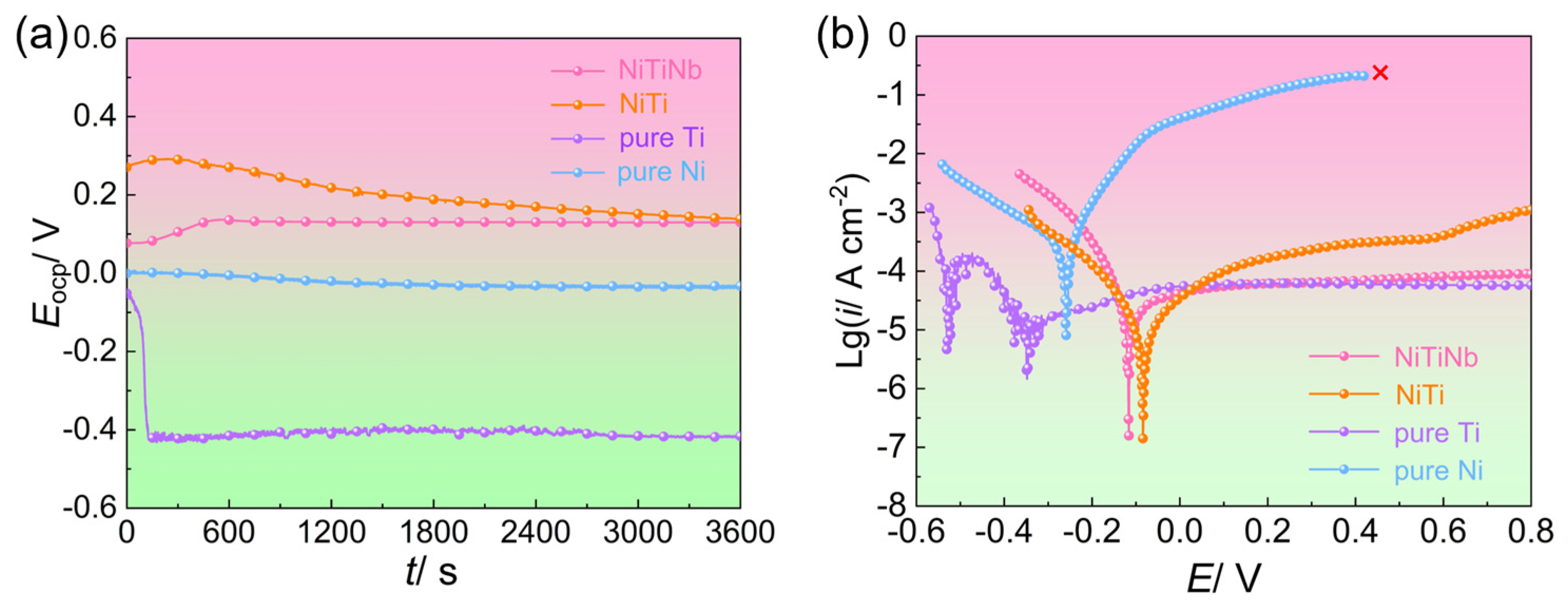
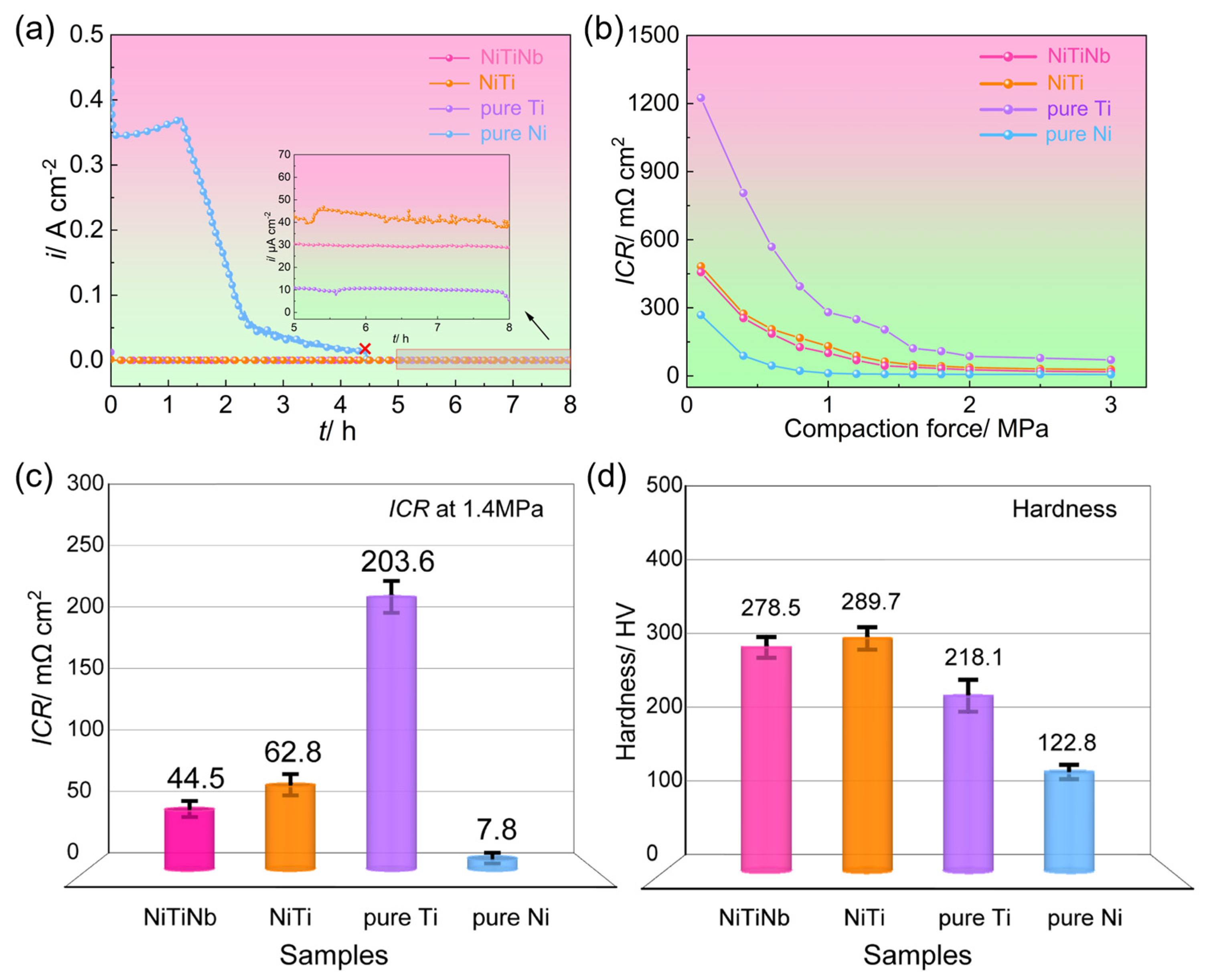
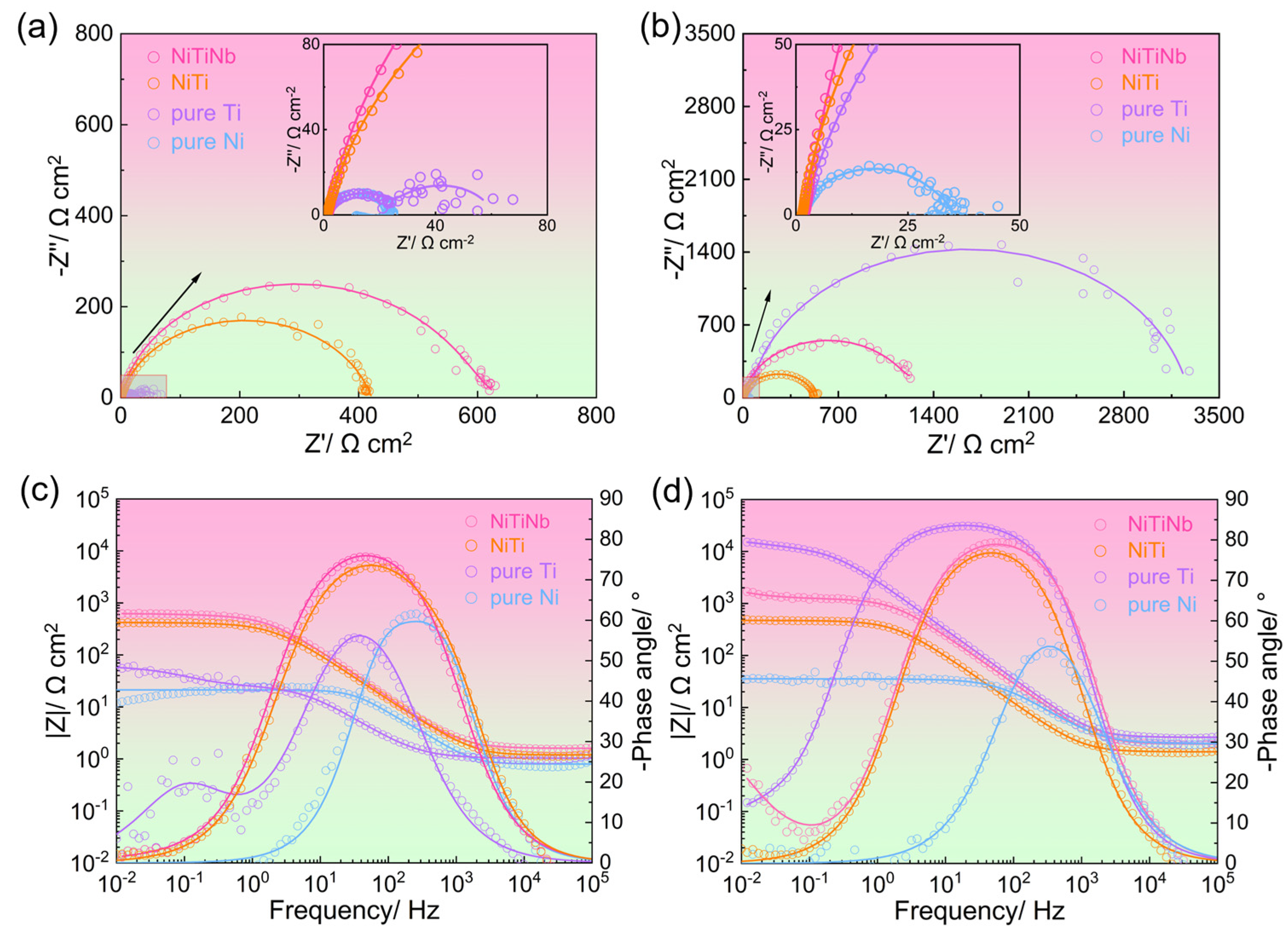

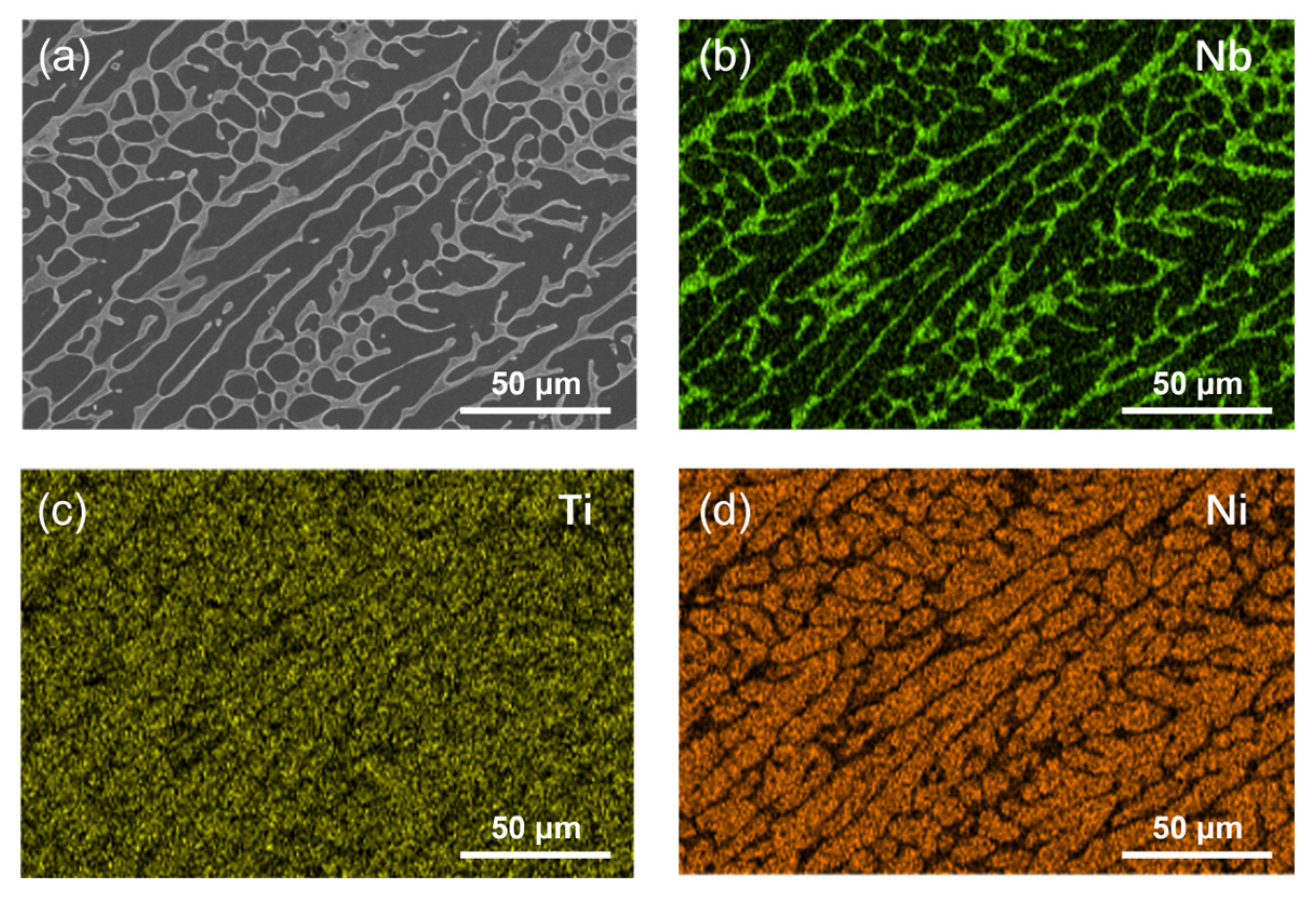
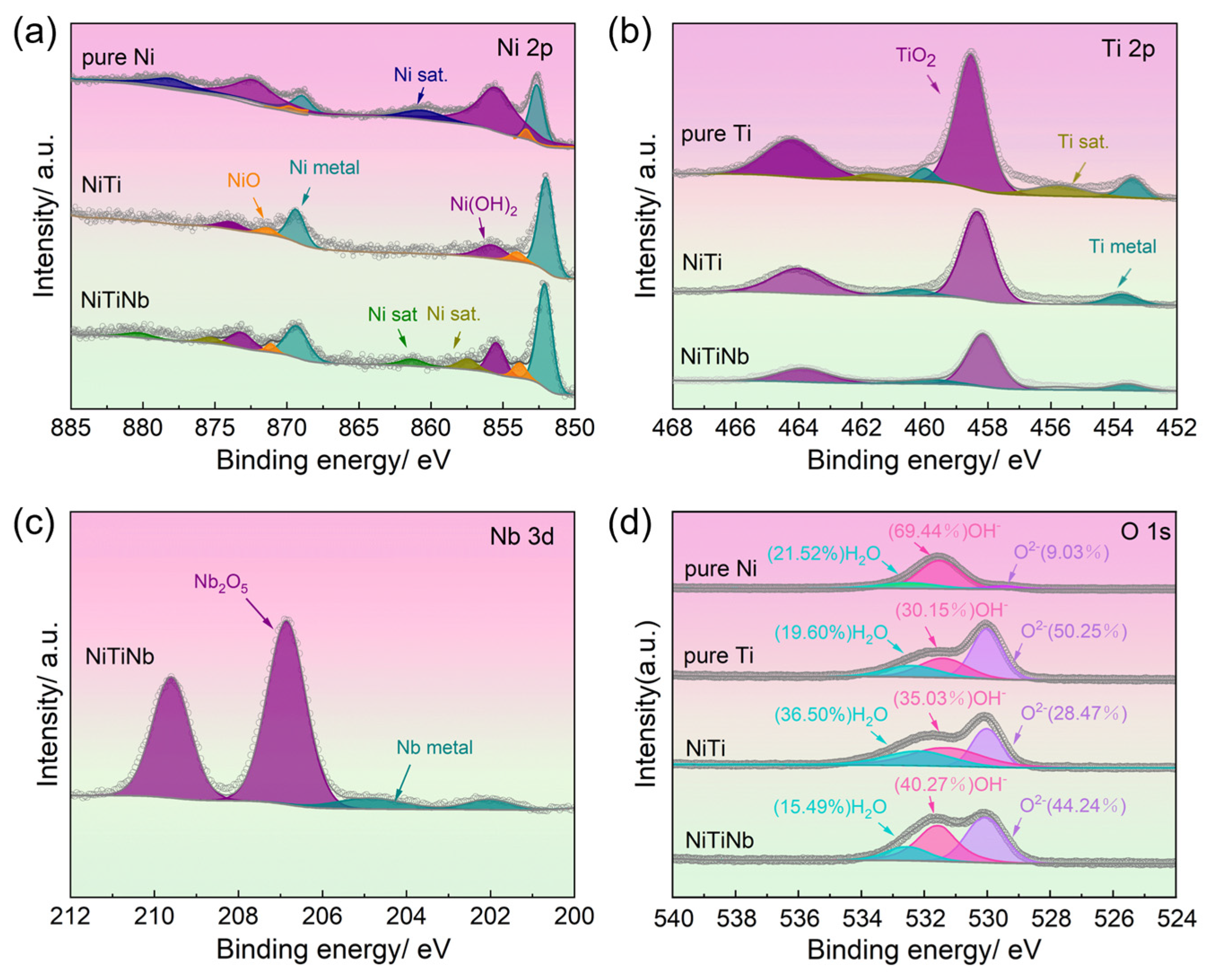
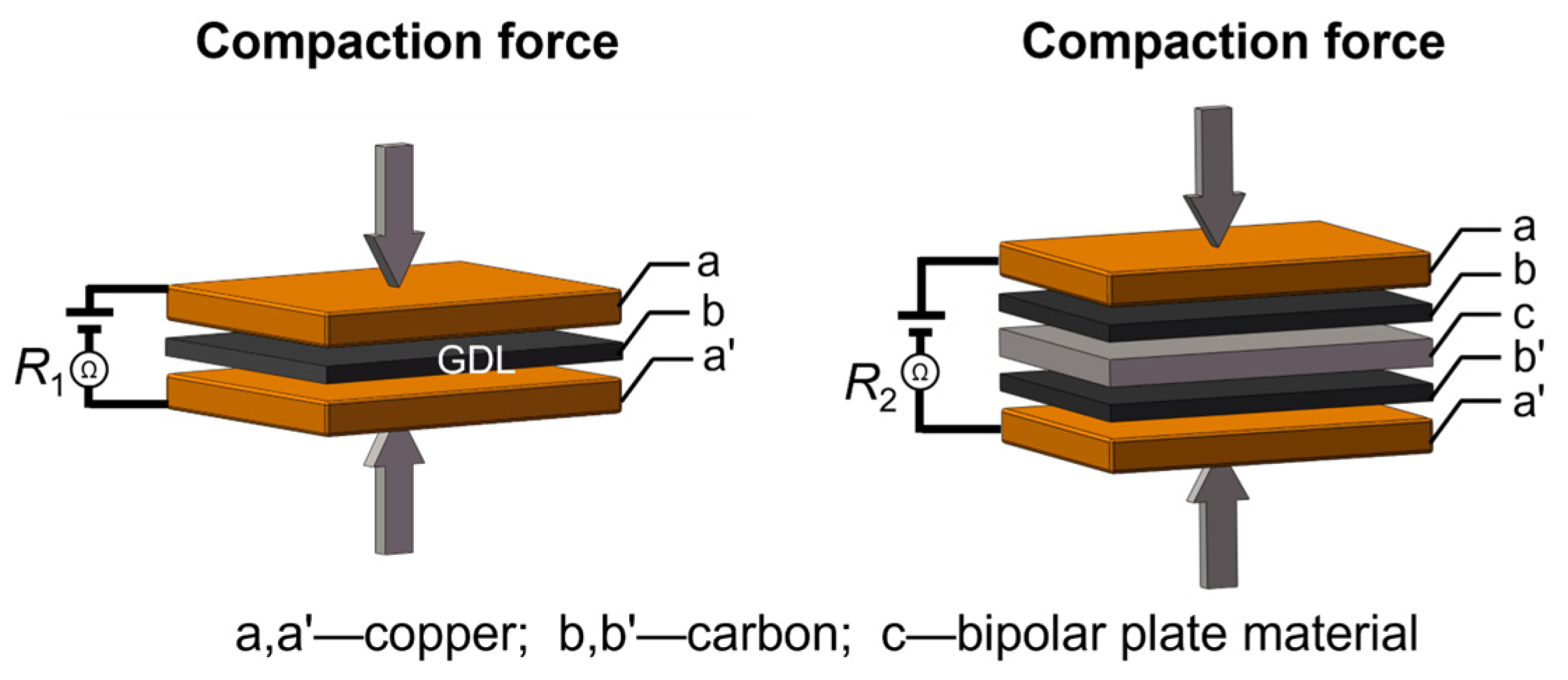
| Samples | EOCP at Steady State (V) | EOCP Standard Deviation During 2400–3600 s (mV) | Ecorr (V) | icorr (μA cm−2) |
|---|---|---|---|---|
| NiTiNb | 0.13 | 0.21 | −0.12 | 5.01 |
| NiTi | 0.14 | 8.98 | −0.08 | 6.51 |
| Pure Ti | −0.42 | 4.76 | −0.53 | 75.95 |
| Pure Ni | −0.03 | 1.43 | −0.26 | 221.23 |
| Before | Elements | Rs (Ω cm2) | Cb (Ω−1 cm−2 sn) | n1 | Rb (Ω cm2) | Cp (Ω−1 cm−2 sn) | n2 | Rp (Ω cm2) | ∑χ2 |
| NiTiNb | 1.59 | 7.02 × 10−3 | 0.53 | 137.6 | 1.88 × 10−4 | 0.91 | 528.2 | 5.34 × 10−3 | |
| NiTi | 1.20 | 7.99 × 10−5 | 0.88 | 7.66 | 2.05 × 10−4 | 0.77 | 413.7 | 8.67 × 10−3 | |
| Pure Ti | 1.03 | 6.23 × 10−2 | 0.82 | 32.11 | 1.82 × 10−3 | 0.85 | 24.97 | 9.62 × 10−3 | |
| Pure Ni | 0.79 | 2.68 × 10−4 | 0.94 | 20.7 | - | - | - | 7.24 × 10−3 | |
| After | Elements | Rs (Ω cm2) | Cb (Ω−1 cm−2 sn) | n1 | Rb (Ω cm2) | Cp (Ω−1 cm−2 sn) | n2 | Rp (Ω cm2) | ∑χ2 |
| NiTiNb | 1.97 | 1.18 × 10−3 | 0.58 | 376.7 | 8.26 × 10−5 | 0.94 | 1030 | 3.18 × 10−3 | |
| NiTi | 1.38 | 1.02 × 10−4 | 0.93 | 363.6 | 1.49 × 10−4 | 0.80 | 520.2 | 6.55 × 10−3 | |
| Pure Ti | 1.71 | 2.05 × 10−4 | 0.89 | 346.8 | 9.81 × 10−5 | 0.99 | 2935 | 9.28 × 10−3 | |
| Pure Ni | 1.67 | 1.60 × 10−4 | 0.89 | 32.9 | - | - | - | 9.08 × 10−3 |
| Samples | Ni 2p (%) | Ti 2p (%) | Nb 3d (%) | O2−/OH− | |||
|---|---|---|---|---|---|---|---|
| NiO + Ni(OH)2 | Metallic Ni | TiO2 | Metallic Ti | Nb2O5 | Metallic Nb | ||
| NiTiNb | 23.87 | 76.11 | 91.37 | 8.63 | 92.53 | 7.47 | 1.10 |
| NiTi | 28.06 | 71.94 | 90.89 | 9.11 | / | / | 0.81 |
| Pure Ti | / | / | 82.31 | 17.69 | / | / | 1.67 |
| Pure Ni | 87.65 | 12.35 | / | / | / | / | 0.13 |
Disclaimer/Publisher’s Note: The statements, opinions and data contained in all publications are solely those of the individual author(s) and contributor(s) and not of MDPI and/or the editor(s). MDPI and/or the editor(s) disclaim responsibility for any injury to people or property resulting from any ideas, methods, instructions or products referred to in the content. |
© 2025 by the authors. Licensee MDPI, Basel, Switzerland. This article is an open access article distributed under the terms and conditions of the Creative Commons Attribution (CC BY) license (https://creativecommons.org/licenses/by/4.0/).
Share and Cite
Niu, Z.; Li, Y.; Li, Y.; Wang, X.; Pan, Y.; He, Z.; Zhang, G.; Wang, Z.; Zhou, Q. Improving Anti-Corrosion and Conductivity of NiTi Alloy Bipolar Plate Used for PEMFCs via Nb Alloying. Molecules 2025, 30, 3658. https://doi.org/10.3390/molecules30173658
Niu Z, Li Y, Li Y, Wang X, Pan Y, He Z, Zhang G, Wang Z, Zhou Q. Improving Anti-Corrosion and Conductivity of NiTi Alloy Bipolar Plate Used for PEMFCs via Nb Alloying. Molecules. 2025; 30(17):3658. https://doi.org/10.3390/molecules30173658
Chicago/Turabian StyleNiu, Ziyang, Yingping Li, Yuanyuan Li, Xiaofen Wang, Yumin Pan, Zhuo He, Guohong Zhang, Zhen Wang, and Qiongyu Zhou. 2025. "Improving Anti-Corrosion and Conductivity of NiTi Alloy Bipolar Plate Used for PEMFCs via Nb Alloying" Molecules 30, no. 17: 3658. https://doi.org/10.3390/molecules30173658
APA StyleNiu, Z., Li, Y., Li, Y., Wang, X., Pan, Y., He, Z., Zhang, G., Wang, Z., & Zhou, Q. (2025). Improving Anti-Corrosion and Conductivity of NiTi Alloy Bipolar Plate Used for PEMFCs via Nb Alloying. Molecules, 30(17), 3658. https://doi.org/10.3390/molecules30173658







